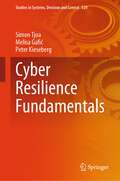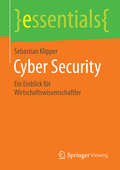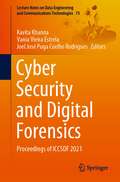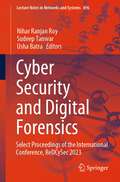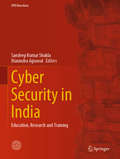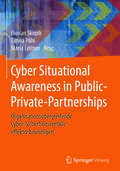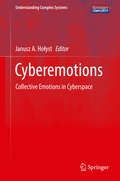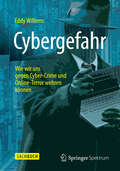- Table View
- List View
Cyber Resilience
by Sergei PetrenkoModern cyber systems acquire more emergent system properties, as far as their complexity increases: cyber resilience, controllability, self-organization, proactive cyber security and adaptability. Each of the listed properties is the subject of the cybernetics research and each subsequent feature makes sense only if there is a previous one.Cyber resilience is the most important feature of any cyber system, especially during the transition to the sixth technological stage and related Industry 4.0 technologies: Artificial Intelligence (AI), Cloud and foggy computing, 5G +, IoT/IIoT, Big Data and ETL, Q-computing, Blockchain, VR/AR, etc. We should even consider the cyber resilience as a primary one, because the mentioned systems cannot exist without it. Indeed, without the sustainable formation made of the interconnected components of the critical information infrastructure, it does not make sense to discuss the existence of 4.0 Industry cyber-systems. In case when the cyber security of these systems is mainly focused on the assessment of the incidents' probability and prevention of possible security threats, the cyber resilience is mainly aimed at preserving the targeted behavior and cyber systems' performance under the conditions of known (about 45 %) as well as unknown (the remaining 55 %) cyber attacks.This monograph shows that modern Industry 4.0. Cyber systems do not have the required cyber resilience for targeted performance under heterogeneous mass intruder cyber-attacks. The main reasons include a high cyber system structural and functional complexity, a potential danger of existing vulnerabilities and “sleep” hardware and software tabs, as well as an inadequate efficiency of modern models, methods, and tools to ensure cyber security, reliability, response and recovery.
Cyber Resilience Fundamentals (Studies in Systems, Decision and Control #520)
by Simon Tjoa Melisa Gafić Peter KiesebergThis book provides readers with the necessary capabilities to meet the challenge of building and testing resilient IT services. Upon introducing the fundamentals of cyber resilience with important international standards and best practices, and the risk management process, the book covers in detail the cyber resilience management process. Here, it gives insights into the principles and design criteria to build cyber resilience in organizations, and to integrate it into operations to contribute to incident preparedness. Further, it describes measures for incident handling, including detection, containment, and post-incident handling, and analyses the most critical aspects of cyber resilience testing, such as auditing, exercising, and testing. Written for advanced undergraduate students attending information security and business continuity management courses, this book also addresses researchers and professionals in the broad field of IT Security and cyber resilience.
Cyber Security: Ein Einblick für Wirtschaftswissenschaftler (essentials)
by Sebastian KlipperIn diesem Buch erfahren Wirtschaftswissenschaftler, wie Firmen nach Hackerangriffen vom Markt verschwinden und wie Hacker Aktienkurse beeinflussen können. Lernen Sie, wie Homo oeconomicus beim Thema Cyber Security zum Homo carens securitate wird und wie es gelingt, mithilfe der wirtschaftswissenschaftlichen „Brille“ (oder: Perspektive/Sicht) ganz neue Lösungsansätze und Sichtweisen im Kampf gegen Wirtschaftsspione, Hacker und Cyber-Kriminelle zu erkennen. Cyber Security bzw. IT-Sicherheit ist ein Zukunftsthema, an dem kaum jemand vorbeikommt. Dieses Buch beschreibt anhand aktueller Vorfälle – ohne technisches Grundwissen vorauszusetzen –, was Ökonomen wissen müssen, um sich am Gespräch über eines der wichtigsten Zukunftsthemen unserer Zeit beteiligen zu können.
Cyber Security: 19th China Annual Conference, CNCERT 2022, Beijing, China, August 16–17, 2022, Revised Selected Papers (Communications in Computer and Information Science #1699)
by Wei Lu Yuqing Zhang Weiping Wen Hanbing Yan Chao LiThis open access book constitutes the refereed proceedings of the 18th China Annual Conference on Cyber Security, CNCERT 2022, held in Beijing, China, in August 2022. The 17 papers presented were carefully reviewed and selected from 64 submissions. The papers are organized according to the following topical sections: data security; anomaly detection; cryptocurrency; information security; vulnerabilities; mobile internet; threat intelligence; text recognition.
Cyber Security and Digital Forensics: Proceedings of ICCSDF 2021 (Lecture Notes on Data Engineering and Communications Technologies #73)
by Kavita Khanna Vania Vieira Estrela Joel José Puga Coelho RodriguesThis book features high-quality research papers presented at the International Conference on Applications and Techniques in Cyber Security and Digital Forensics (ICCSDF 2021), held at The NorthCap University, Gurugram, Haryana, India, during April 3–4, 2021. This book discusses the topics ranging from information security to cryptography, mobile application attacks to digital forensics, and from cyber security to blockchain. The goal of the book is to provide 360-degree view of cybersecurity to the readers which include cyber security issues, threats, vulnerabilities, novel idea, latest technique and technology, and mitigation of threats and attacks along with demonstration of practical applications. This book also highlights the latest development, challenges, methodologies as well as other emerging areas in this field. It brings current understanding of common Web vulnerabilities while maintaining awareness and knowledge of contemporary standards, practices, procedures, and methods of Open Web Application Security Project. It also expounds how to recover information after a cybercrime.
Cyber Security and Digital Forensics: Select Proceedings of the International Conference, ReDCySec 2023 (Lecture Notes in Networks and Systems #896)
by Nihar Ranjan Roy Sudeep Tanwar Usha BatraThe book contains peer-reviewed papers from the International Conference on Recent Developments in Cyber Security organized by the Center for Cyber Security and Cryptology at Sharda University in June 2023. This volume focuses on privacy and secrecy of information, cryptography, applications and analysis, cyber threat intelligence and mitigation, cyber-physical systems, cyber threat intelligence, quantum cryptography and blockchain technologies and their application, etc. This book is a unique collection of chapters from different areas with a common theme and will be immensely useful to academic researchers and practitioners in the industry.
Cyber Security Cryptography and Machine Learning: Third International Symposium, CSCML 2019, Beer-Sheva, Israel, June 27–28, 2019, Proceedings (Lecture Notes in Computer Science #11527)
by Shlomi Dolev Danny Hendler Sachin Lodha Moti YungThis book constitutes the refereed proceedings of the Third International Symposium on Cyber Security Cryptography and Machine Learning, CSCML 2019, held in Beer-Sheva, Israel, in June 2019.The 18 full and 10 short papers presented in this volume were carefully reviewed and selected from 36 submissions. They deal with the theory, design, analysis, implementation, or application of cyber security, cryptography and machine learning systems and networks, and conceptually innovative topics in these research areas.
Cyber Security in India: Education, Research and Training (IITK Directions #4)
by Sandeep Kumar Shukla Manindra AgrawalThis book of 'directions' focuses on cyber security research, education and training in India, and work in this domain within the Indian Institute of Technology Kanpur. IIT Kanpur's Computer Science and Engineering Department established an ‘Interdisciplinary Center for Cyber Security and Cyber Defense of Critical Infrastructures (C3I Center)’ in 2016 with funding from the Science and Engineering Research Board (SERB), and other funding agencies. The work at the center focuses on smart grid security, manufacturing and other industrial control system security; network, web and data security; cryptography, and penetration techniques. The founders are involved with various Indian government agencies including the Reserve Bank of India, National Critical Information Infrastructure Protection Center, UIDAI, CCTNS under home ministry, Ministry of IT and Electronics, and Department of Science & Technology. The center also testifies to the parliamentary standing committee on cyber security, and has been working with the National Cyber Security Coordinator's office in India. Providing glimpses of the work done at IIT Kanpur, and including perspectives from other Indian institutes where work on cyber security is starting to take shape, the book is a valuable resource for researchers and professionals, as well as educationists and policymakers.
Cyber Security Innovation for the Digital Economy: A Case Study of the Russian Federation
by Sergei PetrenkoCyber Security Innovation for the Digital Economy considers possible solutions to the relatively new scientific-technical problem of developing innovative solutions in the field of cyber security for the Digital Economy. The solutions proposed are based on the results of exploratory studies conducted by the author in the areas of Big Data acquisition, cognitive information technologies (cogno-technologies), new methods of analytical verification of digital ecosystems on the basis of similarity invariants and dimensions, and “computational cognitivism,” involving a number of existing models and methods.In practice, this successfully allowed the creation of new entities - the required safe and trusted digital ecosystems - on the basis of the development of digital and cyber security technologies, and the resulting changes in their behavioral preferences. Here, the ecosystem is understood as a certain system of organizations, created around a certain Technological Platform that use its services to make the best offers to customers and access to them to meet the ultimate needs of clients - legal entities and individuals. The basis of such ecosystems is a certain technological platform, created on advanced innovative developments, including the open interfaces and code, machine learning, cloud technologies, Big Data collection and processing, artificial intelligence technologies, etc. The mentioned Technological Platform allows creating the best offer for the client both from own goods and services and from the offers of external service providers in real time.This book contains four chapters devoted to the following subjects:- Relevance of the given scientific-technical problems in the cybersecurity of Digital Economy- Determination of the limiting capabilities- Possible scientific and technical solutions- Organization of perspective research studies in the area of Digital Economy cyber security in Russia.
Cyber Security Innovation for the Digital Economy: A Case Study of the Russian Federation
by Sergei PetrenkoCyber Security Innovation for the Digital Economy considers possible solutions to the relatively new scientific-technical problem of developing innovative solutions in the field of cyber security for the Digital Economy. The solutions proposed are based on the results of exploratory studies conducted by the author in the areas of Big Data acquisition, cognitive information technologies (cogno-technologies), new methods of analytical verification of digital ecosystems on the basis of similarity invariants and dimensions, and “computational cognitivism,” involving a number of existing models and methods.In practice, this successfully allowed the creation of new entities - the required safe and trusted digital ecosystems - on the basis of the development of digital and cyber security technologies, and the resulting changes in their behavioral preferences. Here, the ecosystem is understood as a certain system of organizations, created around a certain Technological Platform that use its services to make the best offers to customers and access to them to meet the ultimate needs of clients - legal entities and individuals. The basis of such ecosystems is a certain technological platform, created on advanced innovative developments, including the open interfaces and code, machine learning, cloud technologies, Big Data collection and processing, artificial intelligence technologies, etc. The mentioned Technological Platform allows creating the best offer for the client both from own goods and services and from the offers of external service providers in real time.This book contains four chapters devoted to the following subjects:- Relevance of the given scientific-technical problems in the cybersecurity of Digital Economy- Determination of the limiting capabilities- Possible scientific and technical solutions- Organization of perspective research studies in the area of Digital Economy cyber security in Russia.
Cyber Situational Awareness in Public-Private-Partnerships: Organisationsübergreifende Cyber-Sicherheitsvorfälle effektiv bewältigen
by Florian Skopik Tímea Páhi Maria LeitnerDigitale Dienste werden für unsere Gesellschaft immer wichtiger, daher gelangen sie auch stärker ins Visier von Wirtschaftskriminellen, Spionen, Terroristen oder staatsfeindlichen Gruppierungen. Wie schützen sich Unternehmen und Staaten vor solchen Cyber-Attacken? Ein wichtiger Grundstein ist die Schaffung von Behörden, wie sie die EU-Richtlinie über Maßnahmen zur Gewährleistung eines hohen gemeinsamen Sicherheitsniveaus von Netz- und Informationssystemen (NIS) vorsieht. Das Buch zeigt, wie sich die Zusammenarbeit von Unternehmen mit diesen NIS-Behörden gestaltet mit dem gemeinsamen Ziel, Cyber-Sicherheit zu etablieren und zu gewährleisten. Darüber hinaus legen die Autoren dar, wie sich die NIS-Richtlinie und die im Mai 2018 in Kraft getretene EU-Datenschutz-Grundverordnung (DSGVO) auf Security-Prozesse in Unternehmen auswirken können. Das Buch verknüpft technische, organisatorische und rechtliche Aspekte der Zusammenarbeit und spiegelt damit die Komplexität des Themas wider. Zugleich liefert es zahlreiche Vorschläge zur Umsetzung der EU-Richtlinie. Im Mittelpunkt steht dabei das Konzept der „Cyber Situational Awareness“ – das bewusste Erfassen der aktuellen Lage – und damit ein Instrument, mit dem sich die Reaktionsfähigkeit bei Cyber-Angriffen wesentlich erhöhen lässt. Folgende Themen werden erläutert: • Aufbau und Nutzung von Cyber Situational Awareness • Erstellung von Cyber-Lagebildern auf nationaler Ebene • Informations- und Datenquellen für Cyber-Lagebilder• Informationsaustausch zwischen Cyber-Lagezentren und Stakeholdern • Informations- und Meldepflichten von Unternehmen• Planspiel zur Bildung und Evaluierung von Cyber Situational Awareness
Cyber Victimology: Decoding Cyber-Crime Victimisation
by Debarati HalderCyber Victimology provides a global socio-legal-victimological perspective on victimisation online, written in clear, non-technical terms, and presents practical solutions for the problem. Halder qualitatively analyzes the contemporary dimensions of cyber-crime victimisation, aiming to fill the gap in the existing literature on this topic. A literature review, along with case studies, allows the author to analyze the current situation concerning cyber-crime victimisation. A profile of victims of cyber-crime has been developed based on the characteristics of different groups of victims. As well, new policy guidelines on the basis of UN documents on cybercrimes and victim justice are proposed to prevent such victimisation and to explore avenues for restitution of justice for cases of cyber-crime victimisation. This book shows how the effects of cyber victimisation in one sector can affect others. This book also examines why perpetrators choose to attack their victim/s in specific ways, which then have a ripple effect, creating greater harm to other members of society in unexpected ways. This book is suitable for use as a textbook in cyber victimology courses and will also be of great interest to policy makers and activists working in this area.
Cyber Victimology: Decoding Cyber-Crime Victimisation
by Debarati HalderCyber Victimology provides a global socio-legal-victimological perspective on victimisation online, written in clear, non-technical terms, and presents practical solutions for the problem. Halder qualitatively analyzes the contemporary dimensions of cyber-crime victimisation, aiming to fill the gap in the existing literature on this topic. A literature review, along with case studies, allows the author to analyze the current situation concerning cyber-crime victimisation. A profile of victims of cyber-crime has been developed based on the characteristics of different groups of victims. As well, new policy guidelines on the basis of UN documents on cybercrimes and victim justice are proposed to prevent such victimisation and to explore avenues for restitution of justice for cases of cyber-crime victimisation. This book shows how the effects of cyber victimisation in one sector can affect others. This book also examines why perpetrators choose to attack their victim/s in specific ways, which then have a ripple effect, creating greater harm to other members of society in unexpected ways. This book is suitable for use as a textbook in cyber victimology courses and will also be of great interest to policy makers and activists working in this area.
Cyberbiosecurity: A New Field to Deal with Emerging Threats
by Dov GreenbaumCyberbiosecurity applies cybersecurity research to the field of biology, and, to a lesser degree, applies biological principles to the field of cybersecurity. As biologists increasingly research, collaborate, and conduct research online, cyberbiosecurity has become crucial to protect against cyber threats. This book provides an overview of cyberbiosecurity through the lens of researchers in academia, industry professionals, and government, in both biology and cybersecurity fields. The book highlights emerging technologies, and identifies emerging threats connected with these technologies, while also providing a discussion of the legal implications involved.This book takes on a multidisciplinary approach, and appeals to both professionals and researchers in the synthetic biology, bioinformatics, and cybersecurity fields.
CyberBRICS: Cybersecurity Regulations in the BRICS Countries
by Luca BelliThis book stems from the CyberBRICS project, which is the first major attempt to produce a comparative analysis of Internet regulations in the BRICS countries – namely, Brazil, Russia, India, China, and South Africa. The project has three main objectives: 1) to map existing regulations; 2) to identify best practices; and 3) to develop policy recommendations in the various areas that compose cybersecurity governance, with a particular focus on the strategies adopted by the BRICS countries to date. Each study covers five essential dimensions of cybersecurity: data protection, consumer protection, cybercrime, the preservation of public order, and cyberdefense.The BRICS countries were selected not only for their size and growing economic and geopolitical relevance but also because, over the next decade, projected Internet growth is expected to occur predominantly in these countries. Consequently, the technology, policy and governance arrangements defined by the BRICS countries are likely to impact not only the 3.2 billion people living in them, but also the individuals and businesses that choose to utilize increasingly popular applications and services developed in BRICS countries according to BRICS standards. Researchers, regulators, start-up innovators and other Internet stakeholders will find this book a valuable guide to the inner workings of key cyber policies in this rapidly growing region.
Cybercrime Investigations: A Comprehensive Resource for Everyone
by John BandlerCybercrime continues to skyrocket but we are not combatting it effectively yet. We need more cybercrime investigators from all backgrounds and working in every sector to conduct effective investigations. This book is a comprehensive resource for everyone who encounters and investigates cybercrime, no matter their title, including those working on behalf of law enforcement, private organizations, regulatory agencies, or individual victims. It provides helpful background material about cybercrime's technological and legal underpinnings, plus in-depth detail about the legal and practical aspects of conducting cybercrime investigations. Key features of this book include: Understanding cybercrime, computers, forensics, and cybersecurity Law for the cybercrime investigator, including cybercrime offenses; cyber evidence-gathering; criminal, private and regulatory law, and nation-state implications Cybercrime investigation from three key perspectives: law enforcement, private sector, and regulatory Financial investigation Identification (attribution) of cyber-conduct Apprehension Litigation in the criminal and civil arenas. This far-reaching book is an essential reference for prosecutors and law enforcement officers, agents and analysts; as well as for private sector lawyers, consultants, information security professionals, digital forensic examiners, and more. It also functions as an excellent course book for educators and trainers. We need more investigators who know how to fight cybercrime, and this book was written to achieve that goal. Authored by two former cybercrime prosecutors with a diverse array of expertise in criminal justice and the private sector, this book is informative, practical, and readable, with innovative methods and fascinating anecdotes throughout.
Cybercrime Investigations: A Comprehensive Resource for Everyone
by John BandlerCybercrime continues to skyrocket but we are not combatting it effectively yet. We need more cybercrime investigators from all backgrounds and working in every sector to conduct effective investigations. This book is a comprehensive resource for everyone who encounters and investigates cybercrime, no matter their title, including those working on behalf of law enforcement, private organizations, regulatory agencies, or individual victims. It provides helpful background material about cybercrime's technological and legal underpinnings, plus in-depth detail about the legal and practical aspects of conducting cybercrime investigations. Key features of this book include: Understanding cybercrime, computers, forensics, and cybersecurity Law for the cybercrime investigator, including cybercrime offenses; cyber evidence-gathering; criminal, private and regulatory law, and nation-state implications Cybercrime investigation from three key perspectives: law enforcement, private sector, and regulatory Financial investigation Identification (attribution) of cyber-conduct Apprehension Litigation in the criminal and civil arenas. This far-reaching book is an essential reference for prosecutors and law enforcement officers, agents and analysts; as well as for private sector lawyers, consultants, information security professionals, digital forensic examiners, and more. It also functions as an excellent course book for educators and trainers. We need more investigators who know how to fight cybercrime, and this book was written to achieve that goal. Authored by two former cybercrime prosecutors with a diverse array of expertise in criminal justice and the private sector, this book is informative, practical, and readable, with innovative methods and fascinating anecdotes throughout.
Cybercrime Risks and Responses: Eastern and Western Perspectives (Palgrave Studies in Cybercrime and Cybersecurity)
by Russell G. Smith Ray Chak-Chung Cheung Laurie Yiu-Chung LauThis book examines the most recent and contentious issues in relation to cybercrime facing the world today, and how best to address them. The contributors show how Eastern and Western nations are responding to the challenges of cybercrime, and the latest trends and issues in cybercrime prevention and control.
Cyberemotions: Collective Emotions in Cyberspace (Understanding Complex Systems)
by Janusz A. HolystThis first monograph of its kind introduces the reader to fundamental definitions, key concepts and case studies addressing the following issues of rapidly growing relevance for online communities: What are emotions? How do they emerge, how are they transmitted? How can one measure emotional states? What are cyberemotions? When do emotions and cyberemotions become collective phenomena? How can one model emotions and their changes? What role do emotions play for on-line communities?Edited and authored by leading scientists in this field, this book is a comprehensive reference for anyone working on applications of complex systems methods in the social sciences, as well as for social scientists, psychologists, experts in on-line communities and computer scientists.This book provides an excellent overview of the current state-of-art in research on collective emotional interactions mediated by the Internet. It introduces a reader in social phenomena occurring in cyberspace, algorithms needed for automatic sentiment detection and data driven modeling of emotional patterns observed in on-line groups.Eugene Stanley, Professor, Boston UniversityWith the explosive hyper-exponential growth of the internet suddenly new ways of communication are emerging that give rise to a digital 'Homo empathicus', each of us suddenly being able to share thoughts and feelings with millions if not billions of others. This book is a true treat, a timely milestone that gives us insight in the co-evolution of the way we interact with each other and the communication technology provided through this new seemingly endless flexible digital world. Prof. Holyst did a great job bringing together real experts in the field of cyber emotions.Peter M.A. Sloot, Professor, University of Amsterdam, the Netherlands, Nanyang University, SingaporeThe book Cyberemotions embraces the topic of emotion studies in cyberspace from a very rich spectrum of points of view and applications. It is particularly interesting reading the theoretical foundations underlying the concepts of cyberemotions and how these concepts can be captured, modeled and implemented in real-time applications.Catherine Pelachaud, Director of Research CNRS at LTCI, TELECOM ParisTechLogical machines give us a chance to analyze our often illogical behaviors, especially in the vast meadows of the cyberspace. In this important book, authors of different backgrounds present a wide and deep image, not only of methods of analyzing our emotional behavior online but also how the computers can help to break communicational walls the same technology had built.Rafal Rzepka, Professor, Hokkaido University
CyberForensics: Understanding Information Security Investigations (Springer’s Forensic Laboratory Science Series)
by Jennifer BayukCyberforensics is a fairly new word in the technology our industry, but one that n- ertheless has immediately recognizable meaning. Although the word forensics may have its origins in formal debates using evidence, it is now most closely associated with investigation into evidence of crime. As the word cyber has become synonymous with the use of electronic technology, the word cyberforensics bears no mystery. It immediately conveys a serious and concentrated endeavor to identify the evidence of crimes or other attacks committed in cyberspace. Nevertheless, the full implications of the word are less well understood. Cyberforensic activities remain a mystery to most people, even those fully immersed in the design and operation of cyber te- nology. This book sheds light on those activities in a way that is comprehensible not only to technology professionals but also to the technology hobbyist and those simply curious about the ?eld. When I started contributing to the ?eld of cybersecurity, it was an obscure ?eld, rarely mentioned in the mainstream media. According to the FBI, by 2009 organized crime syndicates were making more money via cybercrime than in drug traf?- ing. In spite of the rise in cybercrime and the advance of sophisticated threat actors online, the cyber security profession continues to lag behind in its ability to inves- gate cybercrime and understand the root causes of cyber attacks. In the late 1990s I worked to respond to sophisticated attacks as part of the U. S.
Cybergefahr: Wie wir uns gegen Cyber-Crime und Online-Terror wehren können
by Eddy WillemsMan kann online wählen, Rechnungen bezahlen und Tickets kaufen – aber wie sicher ist das? Überall lauern Viren, Spam, Hackerangriffe und sogar Cyber-Spione. Wie kann man sich schützen und wie sollte man dem Phänomen Cyber-Crime begegnen? Der bekannte Security-Experte Eddy Willems gibt einen Überblick über Online-Gefahren und Möglichkeiten, sich vor ihnen zu schützen. Er erläutert spannend die Vergangenheit, Gegenwart und Zukunft des Cyber-Crime.
CyberKnife NeuroRadiosurgery: A practical Guide
by Alfredo Conti Pantaleo Romanelli Evangelos Pantelis Scott G. Soltys Young Hyun Cho Michael LimThis book is a practical guide on image-guided robotic (CyberKnife®) radiosurgery of the brain and the spine. The volume introduces the radiosurgical community to the potential of image-guidance in the treatment of neurosurgical diseases including neuro-oncological, vascular and functional disorders. Principles of image-guided radiosurgery, including physics and radiobiology are considered. Each chapter provides a critical review of the literature and analyses of several aspects to offer an assessment of single and hypofractionated treatments. Based on the authors’ experience, tables or summaries presenting the treatment approaches and associated risks are included as well. Providing a practical guide to define the selection of dose, fractionation schemes, isodose line, margins, imaging, constraints to the structures at risk will support safe practice of neuroradiosurgery. This book aims to shed new light on the treatment of neoplastic and non-neoplastic diseases of the central nervous system using the CyberKnife® image-guided robotic radiosurgery system. It will be adopted by neurosurgery residents and neurosurgery consultants as well as residents in radiation oncology and radiation oncologists; medical physicists involved in radiosurgery procedures may also benefit from this book.
The Cybernetic Brain: Sketches of Another Future
by Andrew PickeringCybernetics is often thought of as a grim military or industrial science of control. But as Andrew Pickering reveals in this beguiling book, a much more lively and experimental strain of cybernetics can be traced from the 1940s to the present. The Cybernetic Brain explores a largely forgotten group of British thinkers, including Grey Walter, Ross Ashby, Gregory Bateson, R. D. Laing, Stafford Beer, and Gordon Pask, and their singular work in a dazzling array of fields. Psychiatry, engineering, management, politics, music, architecture, education, tantric yoga, the Beats, and the sixties counterculture all come into play as Pickering follows the history of cybernetics’ impact on the world, from contemporary robotics and complexity theory to the Chilean economy under Salvador Allende. What underpins this fascinating history, Pickering contends, is a shared but unconventional vision of the world as ultimately unknowable, a place where genuine novelty is always emerging. And thus, Pickering avers, the history of cybernetics provides us with an imaginative model of open-ended experimentation in stark opposition to the modern urge to achieve domination over nature and each other.
The Cybernetic Brain: Sketches of Another Future
by Andrew PickeringCybernetics is often thought of as a grim military or industrial science of control. But as Andrew Pickering reveals in this beguiling book, a much more lively and experimental strain of cybernetics can be traced from the 1940s to the present. The Cybernetic Brain explores a largely forgotten group of British thinkers, including Grey Walter, Ross Ashby, Gregory Bateson, R. D. Laing, Stafford Beer, and Gordon Pask, and their singular work in a dazzling array of fields. Psychiatry, engineering, management, politics, music, architecture, education, tantric yoga, the Beats, and the sixties counterculture all come into play as Pickering follows the history of cybernetics’ impact on the world, from contemporary robotics and complexity theory to the Chilean economy under Salvador Allende. What underpins this fascinating history, Pickering contends, is a shared but unconventional vision of the world as ultimately unknowable, a place where genuine novelty is always emerging. And thus, Pickering avers, the history of cybernetics provides us with an imaginative model of open-ended experimentation in stark opposition to the modern urge to achieve domination over nature and each other.
The Cybernetic Brain: Sketches of Another Future
by Andrew PickeringCybernetics is often thought of as a grim military or industrial science of control. But as Andrew Pickering reveals in this beguiling book, a much more lively and experimental strain of cybernetics can be traced from the 1940s to the present. The Cybernetic Brain explores a largely forgotten group of British thinkers, including Grey Walter, Ross Ashby, Gregory Bateson, R. D. Laing, Stafford Beer, and Gordon Pask, and their singular work in a dazzling array of fields. Psychiatry, engineering, management, politics, music, architecture, education, tantric yoga, the Beats, and the sixties counterculture all come into play as Pickering follows the history of cybernetics’ impact on the world, from contemporary robotics and complexity theory to the Chilean economy under Salvador Allende. What underpins this fascinating history, Pickering contends, is a shared but unconventional vision of the world as ultimately unknowable, a place where genuine novelty is always emerging. And thus, Pickering avers, the history of cybernetics provides us with an imaginative model of open-ended experimentation in stark opposition to the modern urge to achieve domination over nature and each other.

